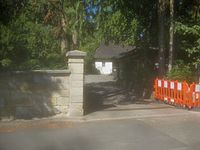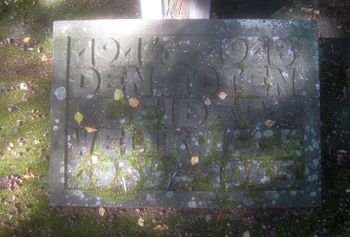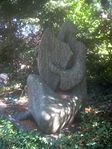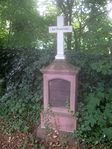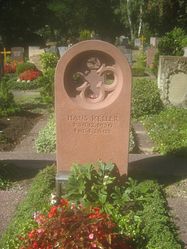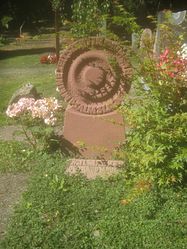Cemetery pipe
The Stuttgart Cemetery Rohr is located in the Rohr district in the Stuttgart-Vaihingen district .
The cemetery was laid out around 1900. It is one of the small Stuttgart cemeteries. Its area covers about 0.7 hectares and is divided into sections 1-10 with about 700 grave sites. On the cemetery grounds there is a morgue, two memorials for the victims of the world wars and almost exclusively graves from the last three decades. The cemetery extends between Schönbuchstrasse in the west and Kopernikusstrasse in the east and is bordered by Hessenwiesenstrasse in the south.
history
Since the 14th century there has been a castle chapel on the site of today's Laurentiuskirche, which was later expanded into a larger church. The churchyard, of which parts of the outer walls have been preserved, was probably also used as a cemetery. After the First World War, the memorial for the victims of the war was erected in this churchyard. Today's Rohr cemetery was built around 1900. In 1926 the nave of the Laurentiuskirche was replaced by a new building designed by the architect Martin Elsaesser (when the old churchyard gate was demolished, a stone with the date 1588 was found in the churchyard wall). The memorial for the victims of the First World War probably had to make way for the new church and was moved to the cemetery.
From the early days of the cemetery, two tombs from 1907 and 1912 have been preserved on the outer wall on Schönbuchstrasse (the graves of forester Karl Reess and local poet Ernst Widmann), all other graves that have been preserved date from 1990 onwards. One grave with a man-high boulder as The tombstone cannot be assigned chronologically because the inscriptions are no longer legible.
Morgue
The morgue in the upper part of the cemetery (in Department 1) is a one-story building with a high, shingle-roofed hip roof and overhanging eaves. The 14-meter-wide hall is parallel to Schönbuchstrasse and can be reached directly via the cemetery entrance on Kopernikusstrasse. A 14 meter long, beam-supported flat roof adjoins the hall, under which there are a few rows of seats for mourners. A side ramp for wheelchair users leads to the covered entrance area. In one corner of this area there is a high relief by an unknown artist on the wall. It shows a guardian angel with long wings, on whose neck a woman in flowing robes, seeking protection, clings.
A semicircular group of seats under tall, shady trees invites you to linger right next to the hall. At the morgue and in some other places there are fountains that date back to when the cemetery was founded. Like the older parts of the cemetery wall, the masonry of the square fountain is made of light-colored sandstone.
|
|
|
Memorials
First World War
In the First World War, 57 young men fell from Rohr. The memorial to the right of the cemetery entrance on Schönbuchstrasse is dedicated to the fallen.
The group of figures on the memorial represents an allegory of the Rohr community mourning their sons who died in World War I. A soldier lying on the ground in a helmet and uniform and with a hand grenade belt around his body, leans his back on his knapsack and gazes at the sky with a broken gaze, his right hand cramped as if in a final exertion of will. A young woman, in a tight, floor-length dress and with a braided headband around her short hair, kneels down in front of the dying man. She puts one hand comfortingly on his chest, with the other she wipes the tears from her face.
The stone group of figures is the work of the Stuttgart sculptor Hermann Jung (1876 – before 1939). It was originally located in the courtyard of the nearby Laurentius Church and was later moved to the cemetery. The substructure consists of a chest-high square plinth and a rectangular plate ( plinth ) resting on it . On the four sides of the base there are stone plaques with the names and date of death of the war victims. The front panel, flanked by two Wehrmacht crosses, bears the inscription “In memory of the sons of the Rohr a / F community who died in the World War 1914-18” (on the Fildern). The list of victims begins below this and continues on the other boards. The left side panel commemorates three missing persons and four men of the community who died as a result of the war.
The memorial suffers from fungal attacks and heavy moss growth. This can be seen as a symbol of impermanence, but in the long run the memorial will be destroyed and the names of the war victims will weather to the point of illegibility.
Second World War
In the Second World War, 148 members of the community fell victim to the war. The memorial to the right of the cemetery entrance on Schönbuchstrasse is dedicated to the fallen and civilian victims of the war.
It was designed in 1956 based on a design by Erich Fritz. The memorial consists of a high cross made of square beams, which was set up in the shady surroundings of bushes and trees. At the foot of the cross is a rectangular, stone relief plate with the inscription "1914 - 18 - The dead of both world wars - 1939 - 45".
Like the memorial for the First World War, the inscription panel suffers from fungal attack and heavy moss growth and will become more and more illegible over time. Unlike the victims of the first war, the victims of the second war are not remembered by name by the memorial. In 2009, Herbert Steimle, a citizen of Vaihingen, suggested erecting two bronze steles with the names of the fallen at the Hochkreuz, a project that had not yet been finalized in 2016.
The memorial includes 3 rows of 16 graves. They carry simple sandstone crosses with the names and dates of life of 4 fallen soldiers and 18 civilian victims of air raids.
|
|
|
Graves
| → Column legend and sorting | ||||||||||
| Legend | ||||||||||
|
||||||||||
| Sorting | ||||||||||
| Illustration | # | P | K | dig | * | † | Artist / object |
|---|---|---|---|---|---|---|---|
| ? | P | Herbert Liedecke , church musician, and his second wife, church musician Eva Hölderlin (? –2007). | 1912 | 1998 | |||
| 01 | P | K | Karl Reess, royal forest warden. | 1871 | 1912 | NN, small white marble cross on a black artificial stone cuboid. | |
| 01 | P | K | Ernst Widmann, music director. | 1891 | 1969 | NN, seated, life-size harpist. | |
| 01 | P | K | Jakob Widmann, local poet. | 1853 | 1907 | NN, white marble cross on a red sandstone cuboid. |
Funerary art
literature
- Christine Bührlen-Grabinger; Dagmar Kraus; Martin Zurowski: Vaihingen, Rohr, Büsnau and Dürrlewang: from the history of a Stuttgart district. Stuttgart 1993, ISBN 3-929315-01-7 .
- Mammut-Verlag (publisher and editor): Stuttgart, Der Friedhofswegweiser. Stuttgart 2011, pp. 90–91 (available free of charge, for example from the information desk in the town hall).
- Kai Müller: Graves of honor in Rohr and Vaihingen. Names should remain legible. In: Stuttgarter-Zeitung.de , July 23, 2014.
- Friedrich Necker: Local history of pipe on the Fildern. Stuttgart 1979, online . - Friedrich Necker (1928–2015) was pastor in Stuttgart-Rohr from 1969 to 1981.
Web links
- Rohr Friedhof on the website of the City of Stuttgart .
- Lists of war victims on the website of the online project Memorials to the Fallen .
Footnotes
- ↑ #Mammut 2011 .
- ↑ #Necker 1979 , # Bührlen-grave Inger 1993 .
- ↑ The red morgue symbol in the cemetery plan is a standard symbol and does not reflect the floor plan of the hall.
- ↑ #Necker 1979 .
- ↑ #Necker 1979 .
- ↑ A list of the war victims mentioned can be found on the website of the online project Memorial Memorials .
- ↑ # Müller 2014 .
- ^ Website of the city of Stuttgart .
- ↑ # Müller 2014 .
- ↑ A list of the war victims buried in the graves can be found on the website of the online project Fallen Memorials .
Coordinates: 48 ° 42 ′ 56.3 " N , 9 ° 6 ′ 19.6" E

